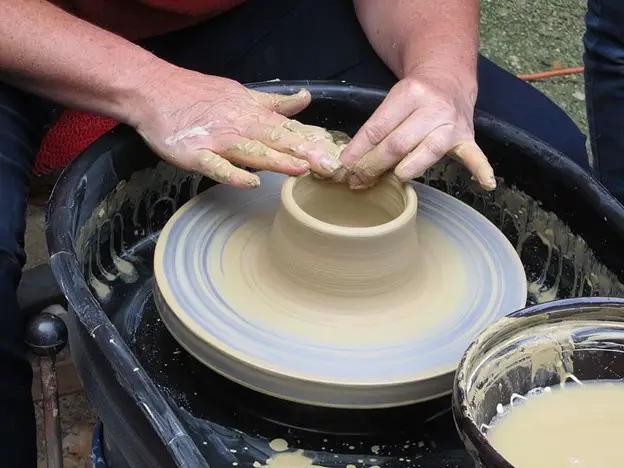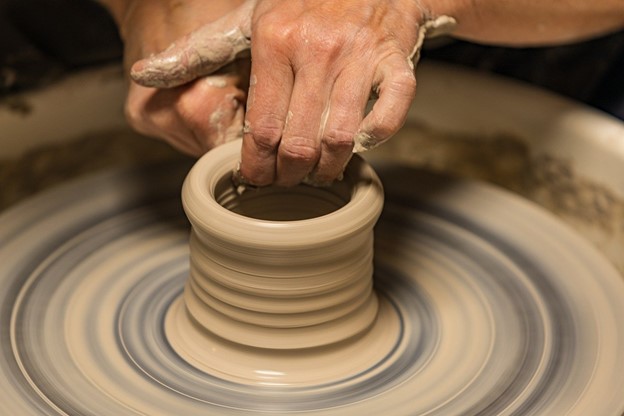Before you start figuring out the wheels and the ways to throw your clay the right way, you must know the right moves to prepare the clay. Preparing your clay correctly helps in successful throwing and helps you prepare some amazing pottery pieces. One question that would surely be ailing you as a beginner crafter is: “How wet should my pottery be when throwing?”
Well, there is no straight answer to this question as it comes with a range of variables. So here, we will check out the factors that determine how wet your pottery should be when throwing.
Factors that Determine the Moisture-Content of the Clay
The amount of water you add to your clay would vary depending on:

1. Clay Type:
Not all clay is equal when it comes to throwing. While some tend to retain moisture better, others can dry out too fast. There are 4 clay variants that include ball clay, earthenware clay, stoneware clay, & porcelain.
Among these 4 clay variants, the earthenware clay tends to retain a good amount of moisture and is ideal for beginners. So, when you are using earthenware, you might not require a lot of water in the molding process. However, when using stoneware or porcelain, you might have to use a lot of water compared to earthenware or ball clay.
2. Plasticity/Moldability:
In order to determine the moisture content in the clay, the key is to check its plasticity or moldability. So, how would you do that? As an artist, you must ensure that the clay is kneaded or wedged properly before you start the throwing process. Doing this helps increase the moldability or plasticity of the clay. The process allows more air to enter the clay while making it light and easy to craft into amazing pieces.
So, how do you determine how much water is needed? Well, when you are kneading the clay, try to observe the texture of the clay. If the clay seems too dry and chunky at parts, it suggests that your piece needs more water. So, try to dab a small amount of water in the piece. Keep kneading and constantly check whether you can feel a smooth texture.
The moment the clay feels smooth, the moisture content is just right for throwing purposes. Apart from this, another trick to determine whether your clay needs water is to create a clay ball and try to tear it into two parts. If it breaks off with little stretching, the water content is at its optimum level. You can also press your finger on the clay and check whether it sticks to the mud. If it doesn’t, the clay is at its right moisture content. However, if the clay sticks on the fingers, you might have added a lot of water and need to mellow it down with some dry clay.
Now that you know how wet your pottery should be when throwing let us check out what you can do if you make a mistake.
What if I add a lot of water to the clay when throwing?
In your journey to craft the perfect piece, you might end up adding more water than is required. So, how would you remove this excess water from the clay?
There are several tricks you can try to wick away the excess moisture from the clay.
- You can simply place some dry papers on the clay and wait for it to wick away the unnecessary moisture. After a few hours, gently lift the paper and check whether the clay has achieved a perfect consistency. If it hasn’t, you can repeat the process until the extra moisture has been wicked away. Do not let the paper sit out for too long, or the clay will dry out a lot.
- Alternatively, you can leave the clay as it is. Then, slowly, the water from the clay would evaporate, and you will be left with dried-out clay that can be molded as you want.
- You can also use a good-quality hair dryer or fan to speed up the drying process that helps evaporate the unnecessary water from the clay. However, make sure you don’t do it too much, or the clay will become dust.
Here are some things to keep in mind when throwing clay to avoid unnecessary dry-out or water absorption:
Tips |
Result |
| Never pull up the walls too fast | Doing this tends to expose a larger surface area of clay to air leading to dry out faster |
| Ensure the walls aren’t too thin | Thinner walls tend to dry out pretty fast, and this could render your piece difficult to mold |
| Use a sponge to dab water | When trying to keep your clay wet, the right way is to use a sponge as it helps dab in the perfect amount of water |
What if the clay is too dry when throwing?
When throwing clay to craft a pottery piece, make sure the clay should be sticky and soft. However, it shouldn’t be dripping wet and should be easy to pick without leaving behind any watery stains. In case your clay is too dry when throwing, you wouldn’t be able to center it the right way.
Moreover, even if you manage to center it, you won’t be able to pull up the walls, and they would break up as you are pulling it up. Generally, the highest amount of water is used when you are kneading the clay. This is when you can achieve perfect consistency. However, even as you knead it, the clay tends to lose some water as it is exposed to the environment surrounding it.
This is why you need to keep adding water as you mold the clay and even when you are shaping it up. You can make use of the sponge dab method to ensure that you do not accidentally use a lot of water. With the right piece of sponge, you can get the job done with ease. The Royal Brush Artist Sponge is ideal for pottery, walls, and ceramic artistry. Keep repeating the process if you feel the clay is too dry or starts scraping your hands as you shape it. You can also use your fingers to add the right amount of water while shaping it up. Simply dip the hands in water and mold the clay.
Conclusion
With pottery throwing, you need to keep in mind that the quicker you work, the less water you would need. So, if you are a beginner, you might need more water than an expert pottery artist who is good at throwing. You can also replace water with slip for better efficiency when throwing clay, as it helps ensure the clay doesn’t dry out fast.







